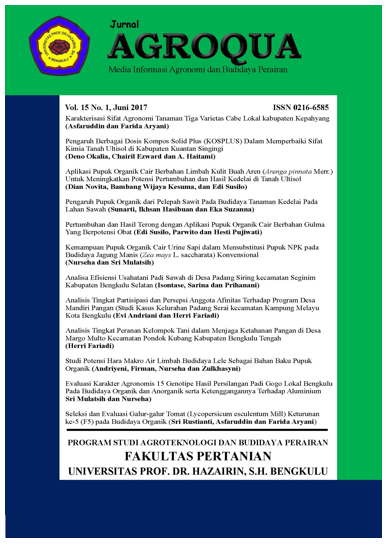RESPON TANAMAN CABAI MERAH (Capsicum annum L.) TERHADAP KOMPOSISI DAN DOSIS BOKASHI PELEPAH SAWIT DAN DAUN REMUNGGAI
DOI:
https://doi.org/10.32663/ja.v19i2.2166Keywords:
Bokashi, Composition, Chili, DosageAbstract
This experiment aims to determine the response of red chili (Capsicum annum L.) plants to the composition and dosage of bokashi oil palm and remunggai (Moringa oleifera). This research was conducted from January to April 2021, in Kayu Arang Village, Sukaraja District, Seluma Regency. The design used was a Factorial Completely Randomized Desing (CRD). The first factor is the composition (A) namely: A1: remunggai + palm frond (1:1), A2: remunggai + palm frond (1:3), A3: remunggai + paln frond (1:5) and the second factor is bokashi dose (B) namely: B0 : 1 ton/ha bokashi + NPK recommendation, B1 : 10 ton/ha bokashi, B2 : 20 ton/ha bokashi, B3 : 30 ton/ha bokashi, B4 : 40 ton/ha bokashi. The treatment was repeated 3 times to produce 45 experimental units. The result of the analysis of variance was continued with Duncan’s Multiple Range Test (DMRT) with a test level of 5%. The results showed that giving bokashi composition had on significant effect on all observed variables. Meanwhile, in giving bokashi dose, there were observational variables that had a significant effect, namely plant height, number of productive branches, the total number of fruit per plant, fruit weight per plant, the weight of dry stover stove, and the parameters of variables that had no significant effect were flowering age and age harvest.
Downloads
Published
Issue
Section
License
Authors who publish with this journal agree to the following terms:
- Authors grant the journal right of first publication with the work simultaneously licensed under a Creative Commons Attribution 4.0 Internasional (CC BY 4.0) Licence that allows others to use and share the work with an acknowledgment of the work's authorship and initial publication in this journal.
- The author(s) still hold the copyright of his/her/their work and retain publishing rights without restrictions such as (but not limited to) patent right, lecture, book and reproduce the article for own purposes.
















